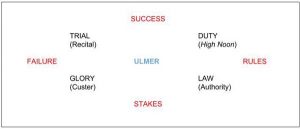Cheshire Diagrams 2

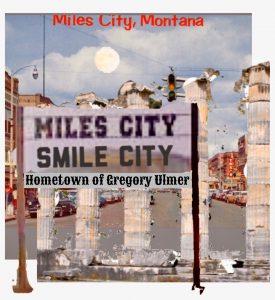
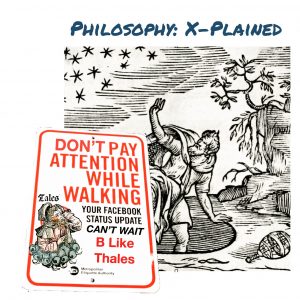
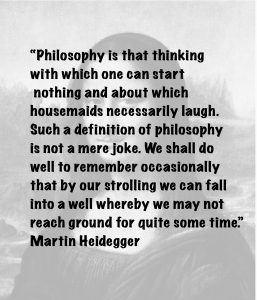
Slides for a lost lecture.


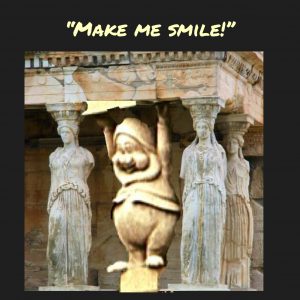
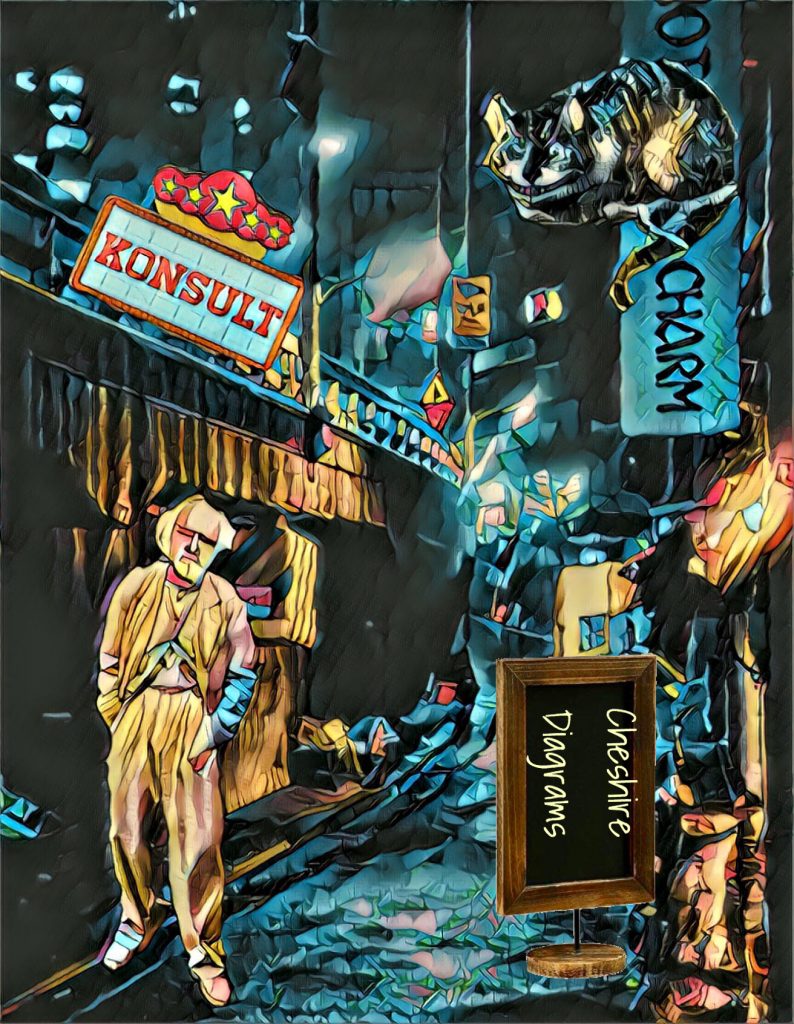
Cheshire Diagrams: Coming Soon
 Michael Faraday: Electricity
Michael Faraday: ElectricityElectracy (the term) joins electricity and trace to name the digital apparatus. Michael Faraday made a major contribution to the science and technology of electracy (he is considered to be the first electrical engineer). His work exemplifies a principle of heuretics regarding the transdisciplinary character of creativity. His discovery of the unity of electricity and magnetism was guided by a themata (Holton)–the unification of all forces in the cosmos–which directed his empirical work. The following passage holds a place for further discussion.
But Faraday was not wholly without philosophical intent. As a young man, he became enamored of a version of Kant’s philosophy extolled with great force by the poet Samuel Taylor Coleridge. It was based on the universe being filled with a web of attractive and repulsive forces, convertible one into the other, with their total being conserved. At the bottom, this cosmic web was woven by God. Everything is here in nascent form, including forces to fill the vacuum, as well as conservation of energy. Faraday was particularly taken by Coleridge’s statement that “Things identical must be convertible.” He believed a relation between electrical and magnetic forces had to exist. As Faraday’s biographer L. Pierce Williams writes, “It was the conviction that forces were inherently identical and convertible that inspired Michael Faraday during the major portion of his scientific career.” (Arthur I. Miller, Insights of Genius: Imagery and Creativity in Science and Art, MIT Press, 2000: 102).
The immediate point to register is to extend the unification of forces (energy) into the cultural and human realm, with respect to the axis of attraction-repulsion as organizing electracy, including the libidinal economy of desire. An abstract of an essay by Williams notes a further correlation of Faraday with the metaphysics structuring konsult as pedagogy: Capabilities.
This chapter focuses on epistemology and the experimental methods used by Michael Faraday. The methods of all sciences are identical. These methods include observation of facts, comparison and classification of facts, deduction of facts, and verification of results. Science guided Faraday throughout his life. It must have infuriated his contemporaries that the foremost experimentalist of the nineteenth century rejected the prevalent theories of experimental method. In fact, Faraday’s scientific career was founded upon a rather simple, but fundamentally important, concept of the mind and its faculties. The mind consists of basically three faculties—the senses, the judgment, and the imagination. The senses provide the mind with the raw material for its operations but this is not automatic or mechanical. The mind has to be carefully trained in the reception of sense impressions or else it will err in its judgments. (“Epistemoloogy and Experiment: the Case of Michael Faraday,” Studies in Logic and the Foundations of Mathematics, Vol 49, 1968).
Lacan offered seminars annually from 1952 to 1980. Lacan’s seminars make an important contribution to the Theory in the CATTt guiding the invention of Konsult in general, and theopraxesis in particular. In this later seminar Lacan makes explicit some connections with the sources of our project that until now operated as assumptions. The first of these relationships is outlined here.
Capabilities.
Real, imaginary, and symbolic strikes me as just as valid as the other triad from which, going by Aristotle, the juice was extracted to compose man, namely, will, intelligence, and affectivity. (Sinthome 126).
As discussed in the book, Konsult: Theopraxesis, one function of our experiment is to support a transition from literacy to electracy in education (to negotiate a passage from one apparatus to another). The pedagogy is centered on egents, the ones supposed to learn, appropriating the resources of Arts & Letters curriculum as means for students to undergo and develop their capabilities—their faculties, powers, virtues, potentiality—identified in the tradition dating from the invention of literacy in the Athenian academies as the embodied intellectual virtues: Theoria, Praxis, Poesis (theory, practice, poetics; thinking, doing, making; understanding, will, imagination). Kant’s Three Critiques take up this thread. The Third Critique promotes Aesthetics to equal status with Science and Morality, to propose aesthetic judgment as mediator bridging the abyss separating science and religion. Hannah Arendt took up Kant’s project as the best option for a Public Sphere in industrialized mass society after Auschwitz.
The importance of Lacan’s contribution is apparent in this context. His mnemonic image of the embodied virtues is a bag (the body, mathematically the empty set, the one) tied closed with cord (string, ficelles). RSI (playing on rhymes and puns with “heresy” and “airesis” or choice)—Lacan’s updating of the three faculties—Real, Symbolic, Imaginary—interrelate topologically, entangled in a way that Lacan explores through knot topology, with the Borromean knot specifically manifesting the sinthome (unique symptom). We have argued elsewhere that the sinthome helps account for the image of wide scope. One implication to be tested in our experiments is that in experience we encounter the apparatus stack (the popcycle) as entangled, knotted, in a manner articulated by topology. Lacan supplies one guide for the Kant-Arendt project, that we are calling theopraxesis: the virtues and their institutions already are fully integrated in a potential state (dunamis, but in a condition of privation, steresis). The “symptom” of this virtual condition is the polemos or seemingly irreducible conflict apparent in relations both macrocosmic and microcosmic of civilization.
HOGARTH: Line of Beauty
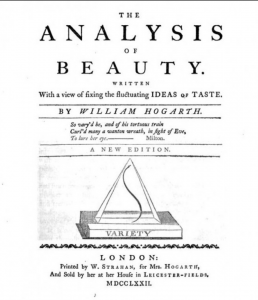 A second affiliation with tradition important to note in this seminar is Lacan’s reference to Hogarth’s curved line of beauty as relevant to the genealogy of his knot topology. This connection makes explicit Lacan’s contribution to the larger question of the gramme, the invention of the plasmatic line in the Paleo apparatus, in continuing service up to the present, now augmented in electracy through animation and digital FX. Sergei Eisenstein cited Disney’s animated film, Steamboat Willie (1928) as a revelation of the new order opened up in media by the plasmatic line. We will have more to say about the ontological properties of this line.
A second affiliation with tradition important to note in this seminar is Lacan’s reference to Hogarth’s curved line of beauty as relevant to the genealogy of his knot topology. This connection makes explicit Lacan’s contribution to the larger question of the gramme, the invention of the plasmatic line in the Paleo apparatus, in continuing service up to the present, now augmented in electracy through animation and digital FX. Sergei Eisenstein cited Disney’s animated film, Steamboat Willie (1928) as a revelation of the new order opened up in media by the plasmatic line. We will have more to say about the ontological properties of this line.
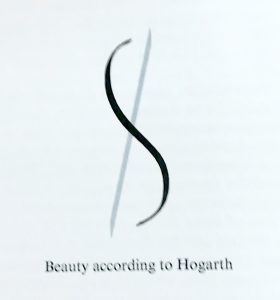
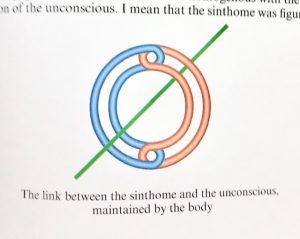
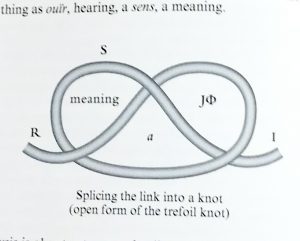
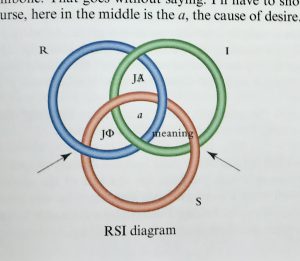
The function of conventional consultants is to compose predictive scenarios. What is the source of inventional konsultant predictions? The sources are three: Paradigm; Aesthetics; Jokes (Richard Feynman’s autobiography is entitled, Surely You’re Joking, Mr. Feynman!).
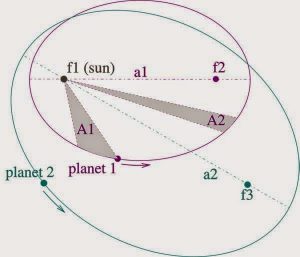
1) Paradigm. I began my career teaching Humanities, a yearlong survey of Western civilization from the Greeks to the present. The course was collaboratively planned and taught, anchored by a comprehensive textbook anthology in several volumes. The most impressive feature of the survey textbook was the introductory overviews to each historical period. The textbook summarized in five or so pages the achievements of historical epochs in every area of civilization (philosophy, art, music, science, politics, economics and the rest), describing the underlying unity of the age. Historians admit that this phenomenon of “spirit of the age,” Weltanschauung, worldview, is mysterious, an effect of description, but nonetheless real in its explanatory role by which people comprehend experience. A more respectable version of the condition is “paradigm,” referring to the parameters of what it is possible to think and say in a given epoch (Michel Foucault). The first (astonishing) observation is that truth has a history. My inference was the possibility of extrapolating that imagined coherence into the present epoch, to assume that our own moment similarly coheres, and inevitably will have been described in terms of a few unifying themes. Adopting this paradigm premise as a guiding principle introduces intelligibility into otherwise chaotic conditions. Thus konsultants today may situate any observation relative to non-Euclidean topologies, relational systems, general equivalencies (commodity form) and similar topoi of our era. The prototype of all relational systems in our era is language, now understood in structuralist terms as a system of material differences based on the human capacity to distinguish phonemes in the flow of sound. The difference between /pig/ and /fig/ (to use Lewis Carroll’s example) is the difference between the sounds /p/ and /f/, apart from any semantic definition. Major thinkers use topological geometry (including knot topologies) to explain Psychoanalysis (Jacques Lacan), Philosophy (Gilles Deleuze), Narratology (René Thom), Architecture (Peter Eisenman), to name a few.
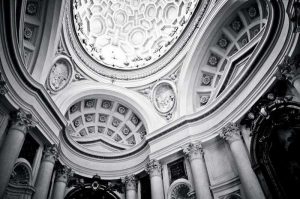 2) Aesthetics. Marshall McLuhan, citing Ezra Pound, declared, artists are the antennae of the race. The general principle is that anything materialized in culture first appears in metaphysics. The heuristic rule is that solutions to dilemmas and impasses (aporias) in experience have already been imagined and represented in the arts. The konsultant tactic is to diagram directly between problem conditions and aesthetic works. A prototype is the Copernican revolution, the heliocentric description of the solar system, in the work of Johannes Kepler, assigned by Tycho Brahe to define the orbit of Mars. After nine years of unsuccessful empirical labor, Kepler realized that the expected circular orbit was not supported by the data, and that the actual orbit traced an ellipse, enabling him to formulate the laws of planetary motion. The five-page textbook survey notes that the dominant aesthetic design of the Baroque period in which Kepler lived is the ellipse. Kepler’s laws of planetary motion are baroque! The heuretic principle proposes to use the correlation of science and aesthetics as predictive, projective, generative. The solution to a given empirical impasse in our era (in the natural and social sciences) already exists potentially in contemporary art. The inventive challenge is to discern which art, which works.
2) Aesthetics. Marshall McLuhan, citing Ezra Pound, declared, artists are the antennae of the race. The general principle is that anything materialized in culture first appears in metaphysics. The heuristic rule is that solutions to dilemmas and impasses (aporias) in experience have already been imagined and represented in the arts. The konsultant tactic is to diagram directly between problem conditions and aesthetic works. A prototype is the Copernican revolution, the heliocentric description of the solar system, in the work of Johannes Kepler, assigned by Tycho Brahe to define the orbit of Mars. After nine years of unsuccessful empirical labor, Kepler realized that the expected circular orbit was not supported by the data, and that the actual orbit traced an ellipse, enabling him to formulate the laws of planetary motion. The five-page textbook survey notes that the dominant aesthetic design of the Baroque period in which Kepler lived is the ellipse. Kepler’s laws of planetary motion are baroque! The heuretic principle proposes to use the correlation of science and aesthetics as predictive, projective, generative. The solution to a given empirical impasse in our era (in the natural and social sciences) already exists potentially in contemporary art. The inventive challenge is to discern which art, which works.
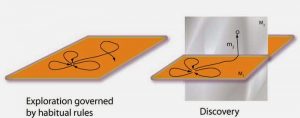 3) Jokes. Arthur Koestler, The Act of Creation, correlated the experience of insight across three fields of experience: humor, science, art (ha-ha, aha!, ah...). The correlation is valuable pedagogically, in that getting a joke (the involuntary nature of laughter) shares the same structure as having an insight of discovery in knowledge and experiencing the aesthetic effect of epiphany in art or literature. The underlying formal structure is the same for all three effects, which is what provides the predictive power. The structure is that of set-up and delivery, bait and switch, relative to the functioning of attention and intentionality in humans, playing on our capacity for surprise. The joke presents a scenario, establishing a certain expectation based on audience familiarity with culture. The narrative pay-off occurs by violating the first expectation, replacing the first scenario with a second one, operating by different rules, also familiar to the audience, but not the default understanding. To give a brief example, Sarah Silverman told this joke: “I really wanted to get an abortion, but my boyfriend and I were having trouble conceiving.” The history of science is full of legendary stories of discoveries made when some serendipitous accident transformed the expectations of an experiment to a different scenario producing Eureka (Penicillin discovered when a mold accidentally contaminated a staphylococcus culture plate). Picasso’s “Bike Bull,” a sculpture evoking the head of a bull made from a seat and handlebars of a bicycle, is an emblematic example. The predictive strategy based on Koestler’s structure is to assume that there is a second scenario available for any set of conventional expectations. Charles Sanders Peirce introduced the term “abduction” to name non-deductive hypothesis creation: The surprising fact, C, is observed. But if A were true, C would be a matter of course. Hence, there is reason to suspect that A is true.
3) Jokes. Arthur Koestler, The Act of Creation, correlated the experience of insight across three fields of experience: humor, science, art (ha-ha, aha!, ah...). The correlation is valuable pedagogically, in that getting a joke (the involuntary nature of laughter) shares the same structure as having an insight of discovery in knowledge and experiencing the aesthetic effect of epiphany in art or literature. The underlying formal structure is the same for all three effects, which is what provides the predictive power. The structure is that of set-up and delivery, bait and switch, relative to the functioning of attention and intentionality in humans, playing on our capacity for surprise. The joke presents a scenario, establishing a certain expectation based on audience familiarity with culture. The narrative pay-off occurs by violating the first expectation, replacing the first scenario with a second one, operating by different rules, also familiar to the audience, but not the default understanding. To give a brief example, Sarah Silverman told this joke: “I really wanted to get an abortion, but my boyfriend and I were having trouble conceiving.” The history of science is full of legendary stories of discoveries made when some serendipitous accident transformed the expectations of an experiment to a different scenario producing Eureka (Penicillin discovered when a mold accidentally contaminated a staphylococcus culture plate). Picasso’s “Bike Bull,” a sculpture evoking the head of a bull made from a seat and handlebars of a bicycle, is an emblematic example. The predictive strategy based on Koestler’s structure is to assume that there is a second scenario available for any set of conventional expectations. Charles Sanders Peirce introduced the term “abduction” to name non-deductive hypothesis creation: The surprising fact, C, is observed. But if A were true, C would be a matter of course. Hence, there is reason to suspect that A is true.


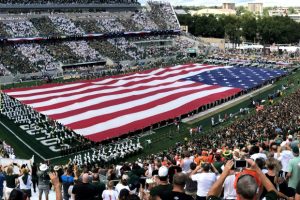
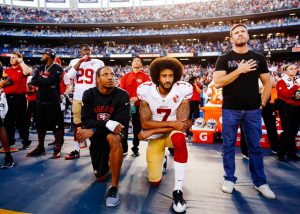

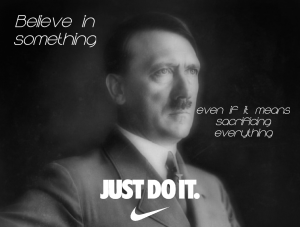

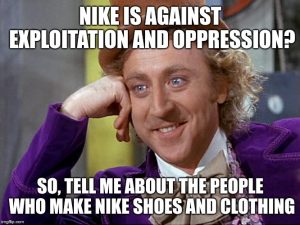
COLIN KAEPERNICK: Paradigm
MEmorial is a genre associated with konsult, whose purpose is to supplement conventional monumentality with a form native to the distributed collective identity of electracy. MEmorial commemorations support political and ethical formation of a fifth estate emerging within social media and entertainment corporate institutions. The event scenario developing around Colin Kaepernick manifests all the features of the genre, including making explicit the meme in MEmorial. This list inventories the unfolding of this case, which may be generalized as exemplary, replicable in principle, adopted as a relay for individual use.
Mystory Curriculum. Mystory may be hermeneutic as well as heuretic, that is, it may be used to organize the curriculum, as part of a transition from literacy to electracy. It is persuasive in any case to find the image of wide scope as a structural principle operating in the arts. Examples of works across media manifesting wide images are assigned in a DH curriculum as exemplars and relays guiding egents in the design of their own wide images.
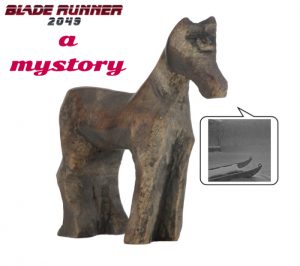 –Blade Runner 2049. A recent example is the Blade Runner sequel, the organizing role played by childhood memories in simulating human identity for replicants. The sequel narrative is motivated by the protagonist’s investigation of the memory of a carved wooden horse. This motif alludes formally and intertextually to the Orson Welles film, Citizen Kane-– the simulated documentary investigation into the enigma of Kane’s identity, his deathbed statement, “Rosebud.” The audience learns that “Rosebud” is the name of Kane’s sled, metonym of his childhood happiness. A konsult curriculum studies these works at several levels, to understand the relationship of lived experience to formal design.
–Blade Runner 2049. A recent example is the Blade Runner sequel, the organizing role played by childhood memories in simulating human identity for replicants. The sequel narrative is motivated by the protagonist’s investigation of the memory of a carved wooden horse. This motif alludes formally and intertextually to the Orson Welles film, Citizen Kane-– the simulated documentary investigation into the enigma of Kane’s identity, his deathbed statement, “Rosebud.” The audience learns that “Rosebud” is the name of Kane’s sled, metonym of his childhood happiness. A konsult curriculum studies these works at several levels, to understand the relationship of lived experience to formal design.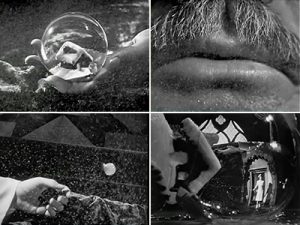
–Intertext. The seminar reads or screens the works mentioned here, analyzing how early memories function in both formal and thematic terms. Citizen Kane, often cited as the best American film ever made, is structured around a journalist’s attempt to solve the mystery of the dying Kane’s last word, “Rosebud.” The audience learns in the final scene that “Rosebud” is the name of Kane’s childhood sled, emblematic of his moment of happiness, in the genre of Proust’s madeleine, whose taste triggered a recollection of happiness whose source it was the goal of the novel to discover. The carved horse, the sled, are vehicles whose tenor the fictional works dramatize, to form hypothetical wide images.
 –Murakami. Another example is 1Q84, by Haruki Murakami, one of whose characters (Tengo) is driven by an early childhood memory. “Murakami’s other protagonist, a writer and math tutor named Tengo, begins 1Q84 in something of an epileptic fit. These attacks strike regularly, we learn (and come to witness), triggered by the bubbling up to consciousness of Tengo’s first memory, witnessed from the crib: ‘His mother had taken off her blouse and dropped the shoulder strap of her white slip to let a man who was not his father suck on her breasts.’ Duly unrepressed, the memory paralyzes his limbs, cuts off his breathing, and occasions the novel’s single most eyebrow-raising sentence: ‘The tsunami’s liquid wall swallowed him whole.'”
–Murakami. Another example is 1Q84, by Haruki Murakami, one of whose characters (Tengo) is driven by an early childhood memory. “Murakami’s other protagonist, a writer and math tutor named Tengo, begins 1Q84 in something of an epileptic fit. These attacks strike regularly, we learn (and come to witness), triggered by the bubbling up to consciousness of Tengo’s first memory, witnessed from the crib: ‘His mother had taken off her blouse and dropped the shoulder strap of her white slip to let a man who was not his father suck on her breasts.’ Duly unrepressed, the memory paralyzes his limbs, cuts off his breathing, and occasions the novel’s single most eyebrow-raising sentence: ‘The tsunami’s liquid wall swallowed him whole.'”
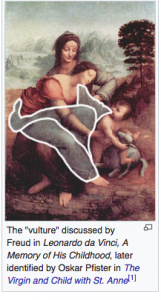 –Leonardo da Vinci. Sigmund Freud’s biographical study of Leonardo featured the one early memory Leonardo recorded in his journals. “It seems that it had been destined before that I should occupy myself so thoroughly with the vulture, for it comes to my mind as a very early memory, when I was still in the cradle, a vulture came down to me, he opened my mouth with his tail and struck me a few times with his tail against my lips.” We will return to these examples later. The point for now is just to note childhood early memories as an important motif in literature, cinema, philosophy, as resource for our heuretic curriculum. Such works are assigned, discussed, interpreted, for their own sake, but also as relays, poetics for design of egent wide images.
–Leonardo da Vinci. Sigmund Freud’s biographical study of Leonardo featured the one early memory Leonardo recorded in his journals. “It seems that it had been destined before that I should occupy myself so thoroughly with the vulture, for it comes to my mind as a very early memory, when I was still in the cradle, a vulture came down to me, he opened my mouth with his tail and struck me a few times with his tail against my lips.” We will return to these examples later. The point for now is just to note childhood early memories as an important motif in literature, cinema, philosophy, as resource for our heuretic curriculum. Such works are assigned, discussed, interpreted, for their own sake, but also as relays, poetics for design of egent wide images.
![]() Allegory of Konsult. Plato in Republic condensed his metaphysics of education in the allegory of the cave, We take this famous story as a relay, prompting us to propose an allegory that dramatizes the equivalent experience of education in electracy. We will explore several possibilities throughout KE, beginning with the film version of The Wizard of Oz, based on the novels by L. Frank Baum. We recall the story of the cave was a round trip: the prisoner released from chains, turned around (converted), led out of the fire-lit cave into the sunlight outside, expected then to return to bring the news of this other world to the cave. This theme of Nostos (round trip, ida y vuelta) structures Homer’s Odyssey, of which Oz is said to be a remake update. A key point in our allegory relative to this tradition is the moment of consulting. Odysseus is prevented from returning home to Ithaca, held in thrall by Circe. Circe relents and tells Odysseus that to learn how to return home he must consult with Tiresias in Hades.
Allegory of Konsult. Plato in Republic condensed his metaphysics of education in the allegory of the cave, We take this famous story as a relay, prompting us to propose an allegory that dramatizes the equivalent experience of education in electracy. We will explore several possibilities throughout KE, beginning with the film version of The Wizard of Oz, based on the novels by L. Frank Baum. We recall the story of the cave was a round trip: the prisoner released from chains, turned around (converted), led out of the fire-lit cave into the sunlight outside, expected then to return to bring the news of this other world to the cave. This theme of Nostos (round trip, ida y vuelta) structures Homer’s Odyssey, of which Oz is said to be a remake update. A key point in our allegory relative to this tradition is the moment of consulting. Odysseus is prevented from returning home to Ithaca, held in thrall by Circe. Circe relents and tells Odysseus that to learn how to return home he must consult with Tiresias in Hades.
–Apparatus. The allegory helps clarify the difference in metaphysics separating the apparati. Each has a fundamental understanding of reality, and each focuses all its resources to manage the system of cause and effect according to the respective realities. In the oral world of Odysseus, gods represent cause, and humans manage this energy by means of ritual, sacrifice, worship. Odysseus’s behavior gave offense to the gods, thus activating the right-wrong metaphysics of orality. To gain access to Hades, Odysseus performs a ritual sacrifice of oxen, collecting the blood, which attracts the spirits of the dead, including Tiresias, who arrives and counsels the hero about his return home. Socrates as gadfly in the streets of Athens performs a literate consultancy, using dialectical logic questioning interlocutors, according to the true-false reality of literate metaphysics. The Wizard of Oz suggests a third manner of consulting, relative to the reality structuring electracy (Fantasy).
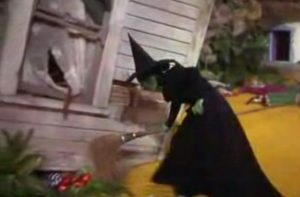 –Scenario. Assuming familiarity with the synopsis of the narrative, we may outline the allegorical import. In general the narrative is instructive of mystorical design in that there is an isotopic rhyming between Dorothy’s world in Kansas and the fantasy world of Oz. The encounter of these two orders is dramatized when Dorothy’s house lands in Oz, crushing the Wicked Witch of the East, whose red shoes Dorothy inherits. The tornado that interrupted a family crisis in Kansas represents Disaster. Dorothy is egent, or soul (psyche) in the allegory, and her journey to find the Wizard to get his advice dramatizes the egent’s actualization of her capabilities in theopraxesis. The three capabilities (virtues, faculties) are represented by the three companions Dorothy meets along the way, the Yellow Brick Road. The three figures embody the significance of the lack articulated in the term “egent” (they lack). The three companions represent the three virtues in a state of privation, Steresis, potentiality not realized (im/potence). Their impotence is a projection of Dorothy’s virtuality, her lack, the condition of any ephebe on the way. The three figures manifest the tripartite system of virtues, but Baum euphemized the assignments somewhat, blending heart and gut. In our appropriation of the story for konsult allegory the alignment with the tradition is clear: Scarecrow wants a brain (Knowledge, Theoria, Head, Rulers); Lion wants courage, so heart (Will, Praxis, Guardians); Tin Woodman’s problem is not his “heart” but his “axe” (enchanted by the witch), which prevents him from loving (having sex). He represents Viscera (Desire, Poiesis, Workers).
–Scenario. Assuming familiarity with the synopsis of the narrative, we may outline the allegorical import. In general the narrative is instructive of mystorical design in that there is an isotopic rhyming between Dorothy’s world in Kansas and the fantasy world of Oz. The encounter of these two orders is dramatized when Dorothy’s house lands in Oz, crushing the Wicked Witch of the East, whose red shoes Dorothy inherits. The tornado that interrupted a family crisis in Kansas represents Disaster. Dorothy is egent, or soul (psyche) in the allegory, and her journey to find the Wizard to get his advice dramatizes the egent’s actualization of her capabilities in theopraxesis. The three capabilities (virtues, faculties) are represented by the three companions Dorothy meets along the way, the Yellow Brick Road. The three figures embody the significance of the lack articulated in the term “egent” (they lack). The three companions represent the three virtues in a state of privation, Steresis, potentiality not realized (im/potence). Their impotence is a projection of Dorothy’s virtuality, her lack, the condition of any ephebe on the way. The three figures manifest the tripartite system of virtues, but Baum euphemized the assignments somewhat, blending heart and gut. In our appropriation of the story for konsult allegory the alignment with the tradition is clear: Scarecrow wants a brain (Knowledge, Theoria, Head, Rulers); Lion wants courage, so heart (Will, Praxis, Guardians); Tin Woodman’s problem is not his “heart” but his “axe” (enchanted by the witch), which prevents him from loving (having sex). He represents Viscera (Desire, Poiesis, Workers).
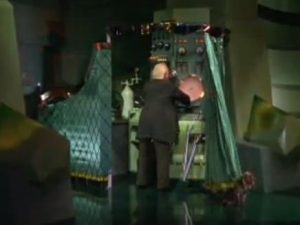 –Wizard. The scene of consultation with the Wizard, when Psyche and her three Capabilities make their requests, shows the full arrangement of apparati and their relationship at the collective level. In this expanded scene, the microcosm/macrocosm individual/collective isotopy is made explicit: Tin Man is Paleo (Family, sexual fertility), Lion is Oral (Church), Scarecrow is Literate (School), Wizard is Electrate (Entertainment). Much theory could be referenced here to support this configuration. To mention Lacan, for example, the Wizard is the Big Other, the one supposed to know, whose hold over us it is the purpose of therapy to dispel. The immediate value of the Oz allegory is to highlight this passage in education, the adventure of learning (dealing with the trials testing Psyche/Dorothy) as actualization of the three capabilities. Equally important is the fact that the Wizard is augmented capability, imagination mise-en-macbine, with the imperative of the allegory being for us to understand how Oz makes able, activates, the three virtues so Dorothy may return home (overcome disaster).
–Wizard. The scene of consultation with the Wizard, when Psyche and her three Capabilities make their requests, shows the full arrangement of apparati and their relationship at the collective level. In this expanded scene, the microcosm/macrocosm individual/collective isotopy is made explicit: Tin Man is Paleo (Family, sexual fertility), Lion is Oral (Church), Scarecrow is Literate (School), Wizard is Electrate (Entertainment). Much theory could be referenced here to support this configuration. To mention Lacan, for example, the Wizard is the Big Other, the one supposed to know, whose hold over us it is the purpose of therapy to dispel. The immediate value of the Oz allegory is to highlight this passage in education, the adventure of learning (dealing with the trials testing Psyche/Dorothy) as actualization of the three capabilities. Equally important is the fact that the Wizard is augmented capability, imagination mise-en-macbine, with the imperative of the allegory being for us to understand how Oz makes able, activates, the three virtues so Dorothy may return home (overcome disaster).

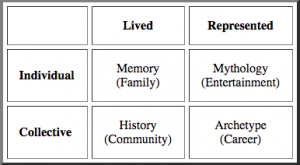 Structuralism: Claude Lévi-Strauss. Following the rule of heuretics curriculum, to treat one’s own materials as belonging to the disciplinary tradition, I applied Lévi-Strauss’s insights into the formal design of mythologies to my wide image. The wide mage in fact is a personal mythology, not only metaphorically but formally. Lévi-Strauss showed that individual instances of a myth manifest a system of relationships, covering all possible variations on the aporia (disaster in our terms) addressed by the myth. The system of relationships is that of proportional analogy (A is to B as C is to D), the figure of hypotyposis encountered throughout the tradition. The practice of myth-work applied to a mystory set (including the Career register documented, along with Family, Entertainment, Community) is to determine which stories/scenes are related in this proportional ratio, along what axes? In my case I found Family and Career related on an axis of space (The Sand and Gravel Plant scene, materializing the Choral metaphor of Plato and Derrida); Entertainment and History related on an axis of time. High Noon plays out almost in real time, intercutting between the clock in the sheriff’s office and the gunmen waiting for their boss to arrive on the noon train, while the sheriff tries to form a posse to fight them. Custer took his Seventh Cavalry far ahead of the rest of the advancing army, hoping to strike a quick blow against the Indians, to get the glory for himself, to propel him into candidacy for President of the United States in the 1876 election.. The symmetries formed in the crossings of this four-fold are provocative, suggestive of a diagram capable of translation into an original hypothesis for konsult.
Structuralism: Claude Lévi-Strauss. Following the rule of heuretics curriculum, to treat one’s own materials as belonging to the disciplinary tradition, I applied Lévi-Strauss’s insights into the formal design of mythologies to my wide image. The wide mage in fact is a personal mythology, not only metaphorically but formally. Lévi-Strauss showed that individual instances of a myth manifest a system of relationships, covering all possible variations on the aporia (disaster in our terms) addressed by the myth. The system of relationships is that of proportional analogy (A is to B as C is to D), the figure of hypotyposis encountered throughout the tradition. The practice of myth-work applied to a mystory set (including the Career register documented, along with Family, Entertainment, Community) is to determine which stories/scenes are related in this proportional ratio, along what axes? In my case I found Family and Career related on an axis of space (The Sand and Gravel Plant scene, materializing the Choral metaphor of Plato and Derrida); Entertainment and History related on an axis of time. High Noon plays out almost in real time, intercutting between the clock in the sheriff’s office and the gunmen waiting for their boss to arrive on the noon train, while the sheriff tries to form a posse to fight them. Custer took his Seventh Cavalry far ahead of the rest of the advancing army, hoping to strike a quick blow against the Indians, to get the glory for himself, to propel him into candidacy for President of the United States in the 1876 election.. The symmetries formed in the crossings of this four-fold are provocative, suggestive of a diagram capable of translation into an original hypothesis for konsult.
–Noon Star Diagram
